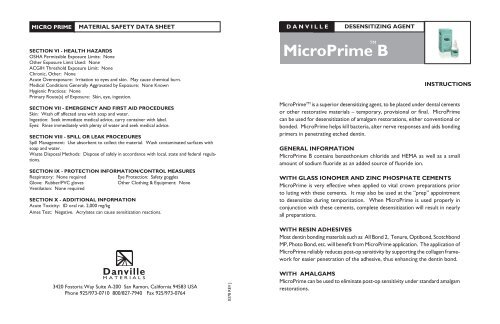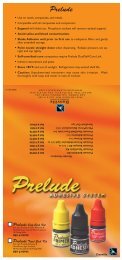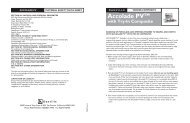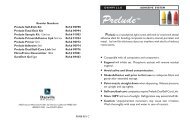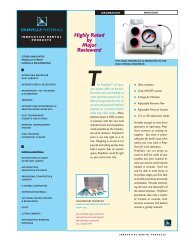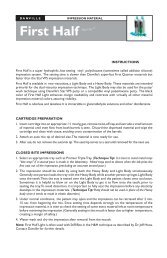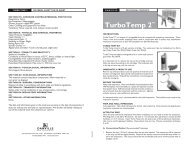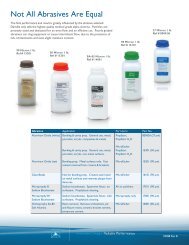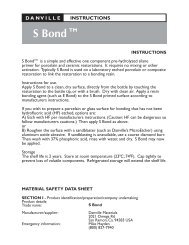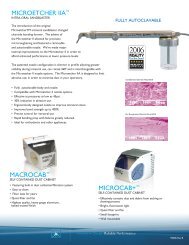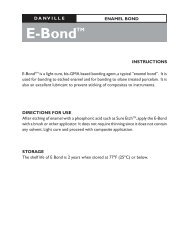0378J MicroPrime B MSDS.indd - Danville Materials
0378J MicroPrime B MSDS.indd - Danville Materials
0378J MicroPrime B MSDS.indd - Danville Materials
Create successful ePaper yourself
Turn your PDF publications into a flip-book with our unique Google optimized e-Paper software.
MICRO PRIME<br />
MATERIAL SAFETY DATA SHEET<br />
D A N V I L L E<br />
DESENSITIZING AGENT<br />
SECTION VI - HEALTH HAZARDS<br />
OSHA Permissible Exposure Limits: None<br />
Other Exposure Limit Used: None<br />
ACGIH Threshold Exposure Limit: None<br />
Chronic, Other: None<br />
Acute Overexposure: Irritation to eyes and skin. May cause chemical burn.<br />
Medical Conditions Generally Aggravated by Exposure: None Known<br />
Hygienic Practices: None<br />
Primary Route(s) of Exposure: Skin, eye, ingestion.<br />
SECTION VII - EMERGENCY AND FIRST AID PROCEDURES<br />
Skin: Wash off affected area with soap and water.<br />
Ingestion: Seek immediate medical advice, carry container with label.<br />
Eyes: Rinse immediately with plenty of water and seek medical advice.<br />
SECTION VIII - SPILL OR LEAK PROCEDURES<br />
Spill Management: Use absorbent to collect the material. Wash contaminated surfaces with<br />
soap and water.<br />
Waste Disposal Methods: Dispose of safely in accordance with local, state and federal regulations.<br />
SECTION IX - PROTECTION INFORMATION/CONTROL MEASURES<br />
Respiratory: None required<br />
Eye Protection: Safety goggles<br />
Glove: Rubber/PVC gloves<br />
Other Clothing & Equipment: None<br />
Ventilation: None required<br />
SECTION X - ADDITIONAL INFORMATION<br />
Acute Toxicity: ID oral rat. 2,000 mg/kg<br />
Ames Test: Negative. Acrylates can cause sensitization reactions.<br />
<strong>Danville</strong><br />
M a t e r i a l s<br />
3420 Fostoria Way Suite A-200 San Ramon, California 94583 USA<br />
Phone 925/973-0710 800/827-7940 Fax 925/973-0764<br />
0378 REV J<br />
TM<br />
<strong>MicroPrime</strong> B<br />
INSTRUCTIONS<br />
<strong>MicroPrime</strong> TM is a superior desensitizing agent, to be placed under dental cements<br />
or other restorative materials – temporary, provisional or final. <strong>MicroPrime</strong><br />
can be used for desensitization of amalgam restorations, either conventional or<br />
bonded. <strong>MicroPrime</strong> helps kill bacteria, alter nerve responses and aids bonding<br />
primers in penetrating etched dentin.<br />
General Information<br />
<strong>MicroPrime</strong> B contains benzethonium chloride and HEMA as well as a small<br />
amount of sodium fluoride as an added source of fluoride ion.<br />
With glass ionomer and zinc phosphate cements<br />
<strong>MicroPrime</strong> is very effective when applied to vital crown preparations prior<br />
to luting with these cements. It may also be used at the “prep” appointment<br />
to desensitize during temporization. When <strong>MicroPrime</strong> is used properly in<br />
conjunction with these cements, complete desensitization will result in nearly<br />
all preparations.<br />
With resin adhesives<br />
Most dentin bonding materials such as All Bond 2, Tenure, Optibond, Scotchbond<br />
MP, Photo Bond, etc. will benefit from <strong>MicroPrime</strong> application. The application of<br />
<strong>MicroPrime</strong> reliably reduces post-op sensitivity by supporting the collagen framework<br />
for easier penetration of the adhesive, thus enhancing the dentin bond.<br />
With amalgams<br />
<strong>MicroPrime</strong> can be used to eliminate post-op sensitivity under standard amalgam<br />
restorations.
MICRO PRIME<br />
INSTRUCTIONS<br />
MICRO PRIME<br />
MATERIAL SAFETY DATA SHEET<br />
Non-bonded restorations<br />
1. Clean tooth prep area.<br />
2. Dry with air (dryness is not critical).<br />
3. Apply <strong>MicroPrime</strong> to dried tooth using brush or cotton pellet. Avoid soft<br />
tissue.<br />
4. Wait 30 seconds, then dry with air.<br />
5. Place restorative material such as amalgam, castings, etc. (Zinc phosphate and<br />
glass ionomer cements work well with <strong>MicroPrime</strong>.)<br />
Bonded Applications<br />
1. Clean tooth prep area.<br />
2. Etch with 10 - 40% phosphoric acid for 15 to 30 seconds.<br />
3. Rinse.<br />
4. Dry with air (dryness is not critical).<br />
5. Apply <strong>MicroPrime</strong>, using brush or cotton pellet. Avoid soft tissue.<br />
6. Wait 30 seconds, then dry or leave moist, per manufacturer’s instructions for<br />
the bonding agent.<br />
7a. Direct restorations: Apply composite bonding agent and composite per<br />
manufacturer’s instructions.<br />
7b. Indirect restorations or sealing preparation: Apply composite bonding agent<br />
and luting resin per manufacturer’s instructions.<br />
Avoid contact with eyes, skin, and mucous membranes. If accidental<br />
contact occurs, FLUSH IMMEDIATLY WITH WATER. CONSULT<br />
PHYSICIAN IMMEDIATLY IF EYE CONTACT OCCURS.<br />
Keep away from children.<br />
Storage and Shelf Life<br />
Expiration date is placed on each <strong>MicroPrime</strong> bottle. <strong>MicroPrime</strong> has a three year<br />
shelf life when kept below 25 O C/77 O F.<br />
0378 REV J<br />
MATERIAL SAFETY DATA SHEET<br />
SECTION I - PRODUCT IDENTIFICATION <strong>MSDS</strong> NO. ROOS<br />
Company:<br />
<strong>Danville</strong> <strong>Materials</strong><br />
3420 Fostoria Way Ste. A-200<br />
San Ramon, CA 94583<br />
Phone: (800) 827-7940<br />
Fax: (925) 973-0764<br />
Prepared: September 1, 2010<br />
SECTION II - HAZARDOUS INGREDIENTS OF MIXTURES<br />
Material<br />
% WGT OSHA PEL ACGIH TLV<br />
Benzethonium Chloride 1-5% 0.2 ppmv 0.2 ppmv<br />
Hydroxylethyl Methacrylate 25-45 NA<br />
NA<br />
Sodium Fluoride<br />
10 ppm NA<br />
N/A<br />
Water<br />
Balance<br />
(ND = Not Determined NA = Not Applicable NL = Not Listed)<br />
SECTION III - PHYSICAL DATA<br />
Vapor Pressure mm HG: NA<br />
Evaporation Rate (Ether = 1): NA<br />
Solubility in Water: Soluble<br />
Appearance: Clear Liquid<br />
Vapor Density (Air = 1): NA<br />
% Volatile by Volume: NA<br />
Boiling Point: NA<br />
Odor: None<br />
SECTION IV - FIRE AND EXPLOSION<br />
Flash Point: >+104 O C<br />
Extinguishing Media: Carbon Dioxide, Foam, Dry Chemical<br />
Special Fire Fighting Procedures: None<br />
Flammable Limits: NA<br />
Unusual Fire and Explosion Hazards: None<br />
SECTION V - REACTIVITY DATA<br />
Stability: Stable<br />
Conditions to Avoid: Prolonged Extreme Heat.<br />
Incompatibility: (<strong>Materials</strong> to avoid) Contact with iron.<br />
Hazardous Decomposition Products: None.<br />
Hazardous Polymerization: None<br />
Conditions to Avoid: Extreme heat and free radical initiators.


